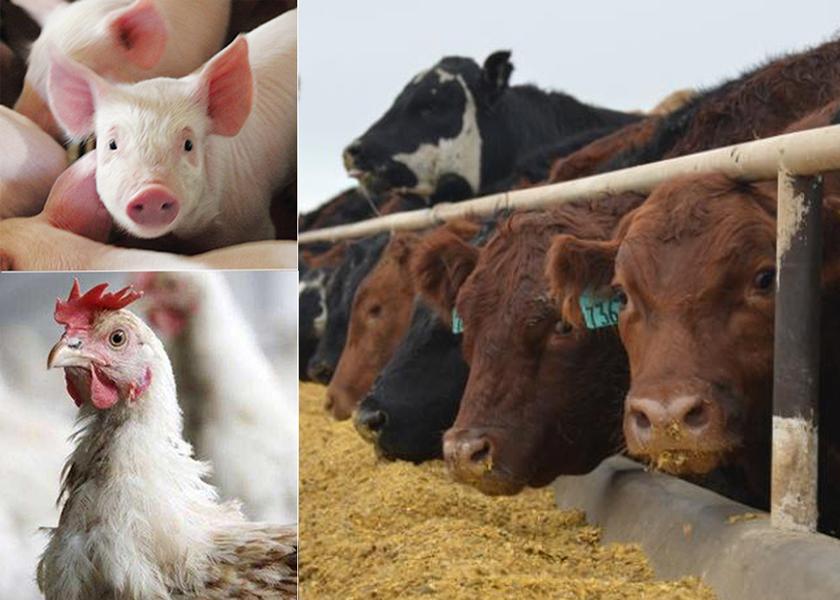Increased Stability and Demand Expected for Livestock Sector, Meyer Says

The unprecedented challenges of 2020 in the livestock and poultry sectors may be in the rearview mirror, but new pressures lie ahead. During USDA’s 97th Agricultural Outlook Forum, USDA chief economist Seth Meyer provided insight into what the livestock and poultry sectors can expect in 2021.
Although livestock and poultry producers will face additional pressure in the form of higher forecast feed costs, Meyer said they will also see a more stable demand pattern with prices averaging above 2020. Total red meat and poultry production is forecast to increase approximately 1% over 2020 production levels. Beef and pork production are forecast to increase over 1% as cattle and hog slaughter is expected to be larger with additional support from heavier carcass weights. Broiler production is expected to expand modestly, with growth constrained in the latter half of the year by higher feed costs.
Overall livestock and poultry prices are forecast higher in 2021, despite higher anticipated year-over-year growth in production. Meyer also noted economic growth and support from an increasingly important export component will support higher livestock and poultry prices in 2021.
For the pork industry specifically, the production forecast is just over 1% higher in 2021 based on greater availability of hogs for slaughter and a return to more typical levels of slaughter following the disruptions to slaughter in mid-2020, he said.
First-half 2021 pork production is predicted to be higher on second-half 2020 pig crops and second half 2021 pork production reflects slightly higher farrowing intentions for first-half 2021 and coupled with growth in pigs per litter. Although the larger expected supplies of hogs will be reflected in higher slaughter during 2021, average carcass weights will reflect a return to a more normal level compared to 2020 slaughter-plant-disruption induced weight gains, he said.
USDA predicts cash receipts, for both crops and livestock, will increase in 2021, driven sharply higher on the strength of corn, soybeans, hogs and cattle, increasing $20.4 billion (5.5%) to $390.8 billion (in nominal terms) in 2021.
Total animal/animal product receipts are expected to increase $8.6 billion (5.2%) with increases in receipts for cattle/calves, hogs, and broilers, and total crop receipts are expected to increase $11.8 billion (5.8%) from 2020 levels, led by higher receipts for soybeans and corn on both increased production and strong prices.
“The economic fundamentals for the agriculture sector remain positive,” Meyer said. “While farm income is expected to decline on sharply falling ad-hoc government COVID-19 assistance, substantial growth in cash receipts for both crops and livestock is projected to support net farm income at 20% above the average of the previous 20 years.”
A Look Beyond Next Season
Meyer said this year’s forecast is subject to the uncertainty of how events may unfold over the coming year. Supply chain disruptions have been mostly mitigated, but bottlenecks continue, including current disruptions in container shipping logistics. Although the majority of agricultural processing disruptions have been addressed, Meyer pointed out that new disruptions are not inconceivable.
“The rise in disposable income (and savings rates) in 2020 with a simultaneous contraction in GDP is likely to unwind in 2021 - as the two indicators again move in opposite directions, as the economy rebounds, supporting what has to date been a robust domestic demand for various livestock and dairy products,” he said.
The reported ongoing recovery of the sow herd from African swine fever (ASF) in China and the expected continued cooling of trade tensions, means growth in feed exports along with continued pork exports, will be important factors for crop and livestock balance sheets.
“U.S. agriculture remains the global leader in supplying food to the world, exporting relatively more of our production than most other countries,” he said.
Meyer noted trends in income growth and shifting dietary patterns, especially in developing countries, toward an increasingly diverse set of crop and animal products. USDA’s recently published long-run projections envisions world demand for beef, pork, and poultry (combined) to increase by more than 17% through 2030.
He noted global consumption of beef, pork, and poultry are projected to grow 8.9%, 17.3% and 16.3%, respectively, between 2021 and 2030. China, accounts for the largest single share of increased consumption of all three meat commodities and a 73% share of the projected increase in pork demand.
Projected demand growth for all meats is fastest among middle income developing regions, including Southeast Asia, Latin America, Africa and the Middle East.
More from Farm Journal's PORK:
PORK Perspectives: A Minute with David Herring
Profit Tracker: Cattle, Hog Margins Improve
Winter Storm Disaster Assistance Available to Livestock Producers







